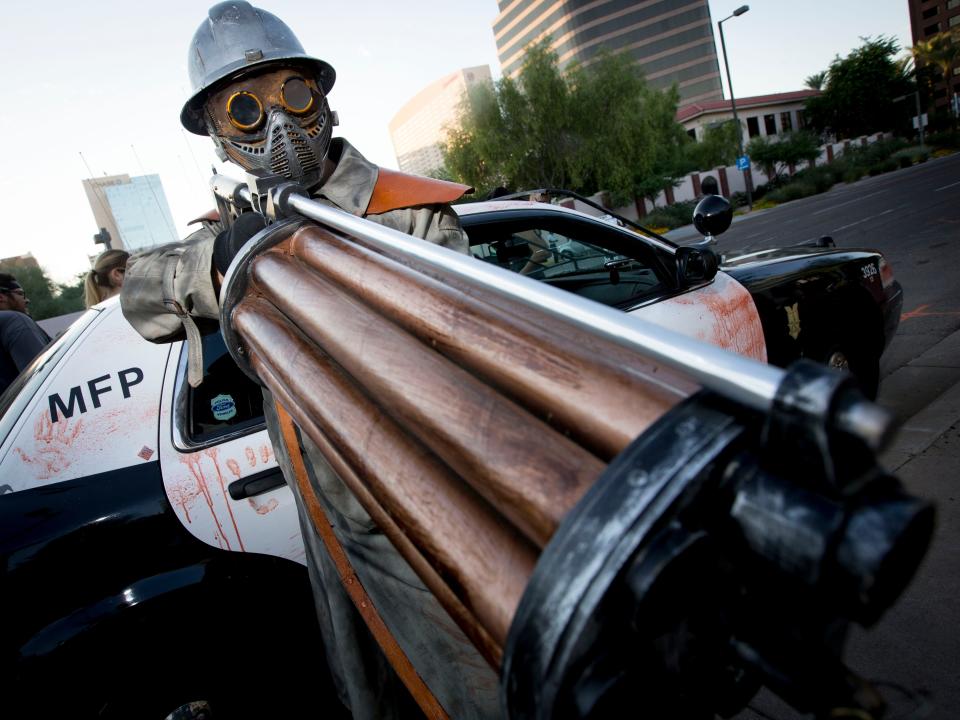'Canal killings': Judge hears about Bryan Miller's 'Zombie Hunter' persona
The story behind Bryan Miller's notorious "Zombie Hunter" persona surfaced in court Wednesday, as Miller's attorneys fight to spare the convicted double murderer from the death penalty.
Before his arrest in 2015, Miller would regularly dress up as the character, appearing at events around Phoenix in his signature helmet, mask and goggles, carrying a large fake gun and driving his modified police car spattered with faux blood.
He would attend comic conventions and other fandom-related events as the Zombie Hunter, building a reputation within the tight-knit costuming community.
Now Miller is facing the prospect of a death sentence, after being convicted last month of murdering Angela Brosso in 1992 and Melanie Bernas in 1993.
The brutal murders of the two young women, randomly attacked as they cycled along Phoenix canals, shocked the city when they occurred 30 years ago. Both young women were stabbed fatally in the back before being mutilated and sexually assaulted as or after they died.
The case ran cold for two decades before Miller was arrested in 2015, following a forensic breakthrough in which detectives matched his DNA to samples at the crime scenes.
He pleaded not guilty for reasons of insanity, but was found guilty of first degree murder, kidnapping and attempted sexual assault in relation to each victim by Judge Suzanne Cohen after a six-month-long bench trial.
Cohen must now decide whether Miller should be sentenced to death or life in prison.
Steampunk interests led to Zombie Hunter costume
The defense has put a number of people from Miller's past on the stand, ranging from childhood neighbors to a one-time Little League coach to a friend from high school to people who knew Miller as an adult.
Mike Syfritt testified Wednesday that he knew Miller through the Arizona Steampunk Society from around 2010 to 2014.
Before Syfritt's testimony, the court watched a 10-minute video explaining Steampunk, a subculture that involves creating and dressing up in costumes inspired by a blend of historic 19th-century and futuristic technology.
Syfritt said he and Miller were both heavily involved in the community and saw each other frequently at events. Miller and his daughter also attended a couple of "build days" at Syfritt's home, where people would gather to create Steampunk-style weapons to go with their costumes and characters.

“He got really into the Zombie Hunter roleplay," Syfritt said, explaining that the character Miller dressed up as was inspired by the "Resident Evil" film and video game franchise.
"He built this persona around the survivalist, surviving a zombie apocalypse," Syfritt said. "The car that he built was basically to mow down zombies."
Syfritt said he had created the fake gun Miller carried as part of the costume.
"It definitely has a history," he said.
He initially made it for his child ahead of a trip to San Diego Comic-Con, Syfritt said, constructing it out of cardboard tubes, a piece of plywood and PVC pipes.
Some time later, he said, he traded it to a woman for an "awesome coat." She passed it on to Miller's ex-girlfriend, which is how it became part of the Zombie Hunter costume.
"Something I would like to point out is that this particular weapon, in the cartoon it was originally designed for, is a non-lethal weapon," Syfritt said.
"It’s supposed to push out this star-shaped projectile that basically pushes somebody back, just to protect themselves," Syfritt said. "That’s the only reason that this gun was around. The character was an insurance agent."
Expert witness: Costume compensated for other issues
Syfritt said he had helped Miller with other aspects of the character, giving him advice on how to get his prescription lenses into the helmet he wore and how to work on his car, which became renowned in the Phoenix subculture.
"It became pretty well known," Syfritt said. "He would park that outside during the car show part of Phoenix Comic-Con, or Fan Fusion, or whatever they call that now."
During the trial, the court heard that Miller wrote on Facebook in 2014 building the "completely insane" vehicle had made him "a little less invisible to the world."
Forensic psychologist Dr. Mark Cunningham suggested Miller used the costume to compensate for his social deficits, which Cunningham said were a symptom of his autism spectrum disorder.
Syfritt said that he knew Miller as a kind and caring guy.
Under cross-examination, he said Miller had never told him that he had been incarcerated as a juvenile or that he had stabbed a woman.
He talked generally about having a rough upbringing with his mother, Syfritt said, but never in detail.
The case returns to court May 15.
This article originally appeared on Arizona Republic: Canal killings: Bryan Miller's 'zombie hunter' persona raised in court

